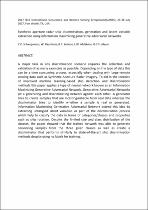 ResearchSpace
ResearchSpace
Impact of increased penetration levels of distributed inverter-based generation on transient stability
JavaScript is disabled for your browser. Some features of this site may not work without it.
- ResearchSpace
- →
- Research Publications/Outputs
- →
- Conference Publications
- →
- View Item
| dc.contributor.author |
Rampokanyo, Mpeli J

|
|
| dc.contributor.author |
Kamera, Ketrine P

|
|
| dc.date.accessioned | 2019-02-04T06:43:33Z | |
| dc.date.available | 2019-02-04T06:43:33Z | |
| dc.date.issued | 2018-06 | |
| dc.identifier.citation | Rampokanyo, M.J. and Kamera, K.P. 2018. Impact of increased penetration levels of distributed inverter-based generation on transient stability. PowerAfrica 2018: 2018 IEEE PES/IAS PowerAfrica Conference, 26-29 June 2018, Cape Town, South Africa, pp. 573-578 | en_US |
| dc.identifier.isbn | 978-1-5386-4163-7 | |
| dc.identifier.isbn | 978-1-5386-4164-4 | |
| dc.identifier.uri | https://ieeexplore.ieee.org/stamp/stamp.jsp?tp=&arnumber=8521139 | |
| dc.identifier.uri | DOI: 10.1109/PowerAfrica.2018.8521139 | |
| dc.identifier.uri | http://hdl.handle.net/10204/10672 | |
| dc.description | Copyright: 2018 IEEE. Due to copyright restrictions, the attached PDF file only contains the accepted version of the published item. For access to the published version, please consult the publisher's website. The definitive version of the work is published at https://ieeexplore.ieee.org/stamp/stamp.jsp?tp=&arnumber=8521139 | en_US |
| dc.description.abstract | The introduction of renewable energy (RE) generation onto the Grid has major benefits such as low carbon footprint on the environment and cheaper or free primary energy sources. However the introduction of RE generation is certainly not without challenges. One major challenge with introduction of nonsynchronous RES on the Grid is erosion of natural inertial energy that is provided by synchronous machines on the Grid. This natural inertial response from synchronous generating sources helps in damping power system swings during system events such as generator trips or sudden loss of a large load. The primary benefit of system inertia in this manner is seen in primary frequency response of the power system, however inertial energy of the machine also directly affects the transient stability of the machine in question. It will be of interest to study how distributed non-synchronous generating sources impact on global transient stability in the power system. This paper will address the impact of increased penetration levels of distributed non-synchronous (static) RE generation on global transient stability of the power system. | en_US |
| dc.language.iso | en | en_US |
| dc.publisher | IEEE | en_US |
| dc.relation.ispartofseries | Worklist;21670 | |
| dc.subject | Static generator | en_US |
| dc.subject | Non-synchronous generator | en_US |
| dc.subject | Inertia | en_US |
| dc.subject | Transient stability | en_US |
| dc.subject | PV generation | en_US |
| dc.subject | Renewable generation | en_US |
| dc.subject | Distributed generation | en_US |
| dc.title | Impact of increased penetration levels of distributed inverter-based generation on transient stability | en_US |
| dc.type | Conference Presentation | en_US |
| dc.identifier.apacitation | Rampokanyo, M. J., & Kamera, K. P. (2018). Impact of increased penetration levels of distributed inverter-based generation on transient stability. IEEE. http://hdl.handle.net/10204/10672 | en_ZA |
| dc.identifier.chicagocitation | Rampokanyo, Mpeli J, and Ketrine P Kamera. "Impact of increased penetration levels of distributed inverter-based generation on transient stability." (2018): http://hdl.handle.net/10204/10672 | en_ZA |
| dc.identifier.vancouvercitation | Rampokanyo MJ, Kamera KP, Impact of increased penetration levels of distributed inverter-based generation on transient stability; IEEE; 2018. http://hdl.handle.net/10204/10672 . | en_ZA |
| dc.identifier.ris | TY - Conference Presentation AU - Rampokanyo, Mpeli J AU - Kamera, Ketrine P AB - The introduction of renewable energy (RE) generation onto the Grid has major benefits such as low carbon footprint on the environment and cheaper or free primary energy sources. However the introduction of RE generation is certainly not without challenges. One major challenge with introduction of nonsynchronous RES on the Grid is erosion of natural inertial energy that is provided by synchronous machines on the Grid. This natural inertial response from synchronous generating sources helps in damping power system swings during system events such as generator trips or sudden loss of a large load. The primary benefit of system inertia in this manner is seen in primary frequency response of the power system, however inertial energy of the machine also directly affects the transient stability of the machine in question. It will be of interest to study how distributed non-synchronous generating sources impact on global transient stability in the power system. This paper will address the impact of increased penetration levels of distributed non-synchronous (static) RE generation on global transient stability of the power system. DA - 2018-06 DB - ResearchSpace DP - CSIR KW - Static generator KW - Non-synchronous generator KW - Inertia KW - Transient stability KW - PV generation KW - Renewable generation KW - Distributed generation LK - https://researchspace.csir.co.za PY - 2018 SM - 978-1-5386-4163-7 SM - 978-1-5386-4164-4 T1 - Impact of increased penetration levels of distributed inverter-based generation on transient stability TI - Impact of increased penetration levels of distributed inverter-based generation on transient stability UR - http://hdl.handle.net/10204/10672 ER - | en_ZA |








